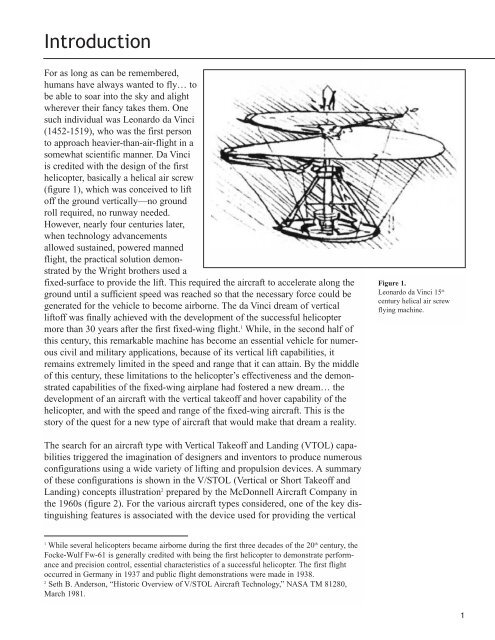XV-15 litho - NASA's History Office
XV-15 litho - NASA's History Office
XV-15 litho - NASA's History Office
You also want an ePaper? Increase the reach of your titles
YUMPU automatically turns print PDFs into web optimized ePapers that Google loves.
Introduction<br />
For as long as can be remembered,<br />
humans have always wanted to fly… to<br />
be able to soar into the sky and alight<br />
wherever their fancy takes them. One<br />
such individual was Leonardo da Vinci<br />
(1452-<strong>15</strong>19), who was the first person<br />
to approach heavier-than-air-flight in a<br />
somewhat scientific manner. Da Vinci<br />
is credited with the design of the first<br />
helicopter, basically a helical air screw<br />
(figure 1), which was conceived to lift<br />
off the ground vertically—no ground<br />
roll required, no runway needed.<br />
However, nearly four centuries later,<br />
when technology advancements<br />
allowed sustained, powered manned<br />
flight, the practical solution demonstrated<br />
by the Wright brothers used a<br />
fixed-surface to provide the lift. This required the aircraft to accelerate along the<br />
ground until a sufficient speed was reached so that the necessary force could be<br />
generated for the vehicle to become airborne. The da Vinci dream of vertical<br />
liftoff was finally achieved with the development of the successful helicopter<br />
more than 30 years after the first fixed-wing flight. 1 While, in the second half of<br />
this century, this remarkable machine has become an essential vehicle for numerous<br />
civil and military applications, because of its vertical lift capabilities, it<br />
remains extremely limited in the speed and range that it can attain. By the middle<br />
of this century, these limitations to the helicopter’s effectiveness and the demonstrated<br />
capabilities of the fixed-wing airplane had fostered a new dream… the<br />
development of an aircraft with the vertical takeoff and hover capability of the<br />
helicopter, and with the speed and range of the fixed-wing aircraft. This is the<br />
story of the quest for a new type of aircraft that would make that dream a reality.<br />
The search for an aircraft type with Vertical Takeoff and Landing (VTOL) capabilities<br />
triggered the imagination of designers and inventors to produce numerous<br />
configurations using a wide variety of lifting and propulsion devices. A summary<br />
of these configurations is shown in the V/STOL (Vertical or Short Takeoff and<br />
Landing) concepts illustration 2 prepared by the McDonnell Aircraft Company in<br />
the 1960s (figure 2). For the various aircraft types considered, one of the key distinguishing<br />
features is associated with the device used for providing the vertical<br />
1 th While several helicopters became airborne during the first three decades of the 20 century, the<br />
Focke-Wulf Fw-61 is generally credited with being the first helicopter to demonstrate performance<br />
and precision control, essential characteristics of a successful helicopter. The first flight<br />
occurred in Germany in 1937 and public flight demonstrations were made in 1938.<br />
2 Seth B. Anderson, “Historic Overview of V/STOL Aircraft Technology,” NASA TM 81280,<br />
March 1981.<br />
Figure 1.<br />
Leonardo da Vinci <strong>15</strong> th<br />
century helical air screw<br />
flying machine.<br />
1

















